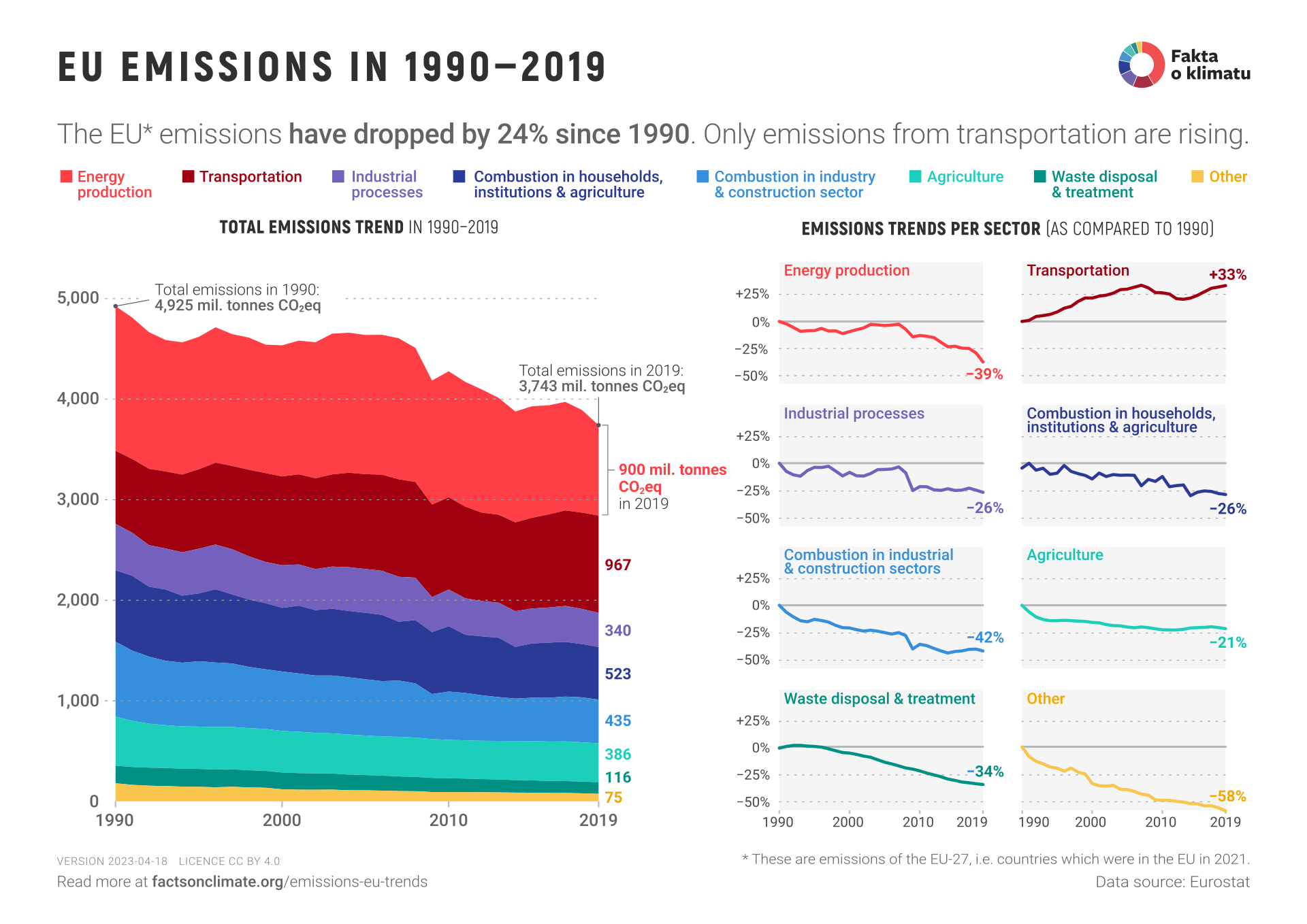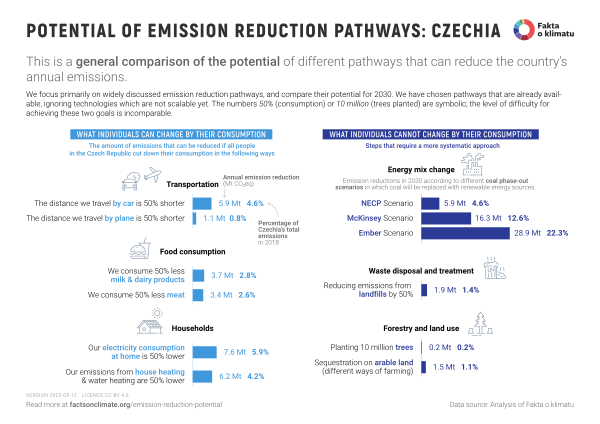Table of Contents
How to read the infographic
- All emission values are given in units of CO2eq.
- The infographic shows anthropogenic CO2 emissions and emissions of N2O, CH4, HFC, PFC, SF6 and NF3 expressed in units of CO2 equivalent (CO2eq). This unit takes into account the long-term effect of greenhouse gases in the atmosphere and converts them into an amount of CO2 that would have the same warming effect. For more, see the article on Global warming potential.
- The left part of the graph shows the absolute emissions of the European Union (more precisely, the EU-27, i.e. the countries that were EU members by 2021) in units of CO2eq over the last three decades. The different areas of human activity are distinguished by colour. On the right-hand side, the relative change in emissions compared to 1990 is indicated for each sector.
- In 1990, emissions in what is now the European Union amounted to 5 billion tonnes of CO2eq. In 2019, it was 3.7 billion tonnes, indicating that EU emissions have fallen by 24% over approximately thirty years. Total EU emissions have been falling more significantly since 2007, after the global financial crisis, in all sectors except transport.
What we see in individual sectors
- Energy: Emissions from the energy sector fell by 39% compared to 1990, to 972 million tonnes of CO2eq per year. Emissions from the energy sector began to decline more significantly after 2007. In recent years we have seen a more rapid decline, which can be expected to continue in the future, given the EU’s commitment to achieving climate neutrality by 2050. Emissions in the energy sector come primarily from electricity and heat production. These emissions can be reduced through energy savings and the development of renewable and low-carbon energy sources. They also come from leakages from fuel extraction, fuel production and treatment and oil processing.
- Transport: Transport emissions increased by 33% compared to 1990 to 968 million tonnes of CO2eq per year. The detailed graph on the right shows a temporary drop in emissions after 2007 due to the global financial crisis and the subsequent economic recession. Since 2013, emissions have risen again. GHG emissions from transport are primarily from the combustion of fossil fuels in the engines of road transport vehicles. (In 2019, 81% of all emissions from the transport sector were from road transport, with aviation accounting for 15%.) It is possible to reduce transport emissions by switching to alternative fuels (e.g., biomethane, CNG, hydrogen or electricity with a simultaneous energy transformation), increasing the share of public transport (train and bus) and reducing the number of vehicles on the road. The volume of road transport can be reduced by increasing vehicle occupancy (carpooling) or generally decreasing the need for transportation (e.g. teleworking).
-
Industrial processes: Emissions from industrial processes have fallen by 26% since 1990, to 343 million tonnes of CO2eq per year. These emissions arise from processes that release greenhouse gases into the atmosphere other than through the combustion of fossil fuels - in the production of chemicals, cement, iron and steel, etc.
For example, emissions from cement production have fallen by almost a quarter since the 1990s. There has also been a decline in the chemical sector, with emissions from ammonia production falling by 34% and nitric acid production falling by 89% (they were still 46 Mt CO2eq in 1990). In contrast, there is a slight increase in emissions from petrochemicals. There are also decreases in iron and steel production (down 35%) and aluminium production (down 85%). Since the 1990s, emissions from the use of refrigerants have increased significantly, replacing the ozone-depleting substances previously used, which are now regulated under the Montreal Protocol. These emissions rose from zero to 88.4 Mt CO2eq in 2014. Since then, these same emissions have been declining, falling to 80.3 Mt CO2eq in 2019. - Residential, institutional and agricultural combustion: Emissions fell by 27% compared to 1990, to 519 million tonnes of CO2eq per year. These emissions arise from heating and hot water (unless a heating plant supplies energy), cooking, etc. They also include fuel combustion in agriculture and forestry.
- Combustion in industry and construction: Emissions fell by 41% since 1990, to 429 million tonnes of CO2eq in 2019. These emissions arise from the combustion of fossil fuels for industrial use, typically when a material needs to be heated in production (during melting, drying, distillation, etc.). For example, emissions from combustion in heavy industry (iron and steel production) have fallen by half from 1990 to 2019.
-
Agriculture: Emissions from the agricultural sector have fallen by 21% since 1990, to 382 million tonnes of CO2eq per year. These emissions come mainly from livestock farming and soil cultivation and associated N2O emissions.
Measures that would lead to a reduction in methane emissions from agriculture include a reduction in the number of livestock kept (and the associated reduction in the consumption of beef and dairy products), a change in the management of manure (for example, by stabilising it in biogas plants), and less intensive fertiliser application. However, reducing livestock farming may also harm soil quality, the availability of natural fertiliser, etc. - Waste management: Emissions from waste management have been declining since the mid-1990s. By 2019, they had fallen by 34% to 114 million tonnes of CO2eq per year. These emissions are mainly produced by landfills, which leak methane into the atmosphere. This methane is produced by decomposing biodegradable material (paper, cardboard, textiles and bio-waste) in the landfill.
- Other: These are emissions not included in the previous categories. Emissions in this category have been steadily declining - down 70% since 1990 to 8 million tonnes of CO2eq in 2019.
Notes on emissions data
- The emission inventory provided by Eurostat uses the CRF (common reporting format) data format and structure. All calculations and reporting methodologies are available on the website of the national greenhouse gas inventory programme (NGGIP - national greenhouse gas inventory programme) and is binding for all countries UNFCCC.
- Data on emissions are provided to Eurostat by individual EU countries - i.e., data for the Czech Republic were reported directly by the Czech Republic, specifically through the European Environment Agency.
- The data correspond to emissions produced in a given country, but exports and imports of goods may not correspond to emissions from consumption in that country. For example, the Czech Republic exports electricity, steel, cars etc., to other EU countries and imports goods from other EU countries or China. The inclusion of air transport is similarly problematic - the air transport contribution shown corresponds to the emissions produced by flights from airports in the EU. It is, therefore, likely to be underestimated and does not fully reflect the amount of emissions caused by Europeans. (For example, a person’s flight from Vienna to Lima with a connection in Atlanta will only be counted as Vienna-Atlanta in the emissions shown, while we consider the emissions from an Atlanta-Lima flight as part of the US.) Also not accounted for is the fact that emissions released high in the atmosphere have approximately twice the effect.
Related infographics and studies
Want to see more? Check out other topic-related infographics and studies:



